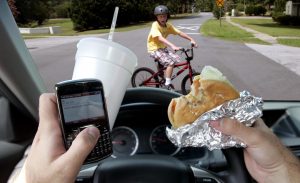
 First of all, the law is NOT new. It has been on the books for several years. All the House Bill 673 did was change some wording redefining what was covered by the law, redefined the fine/points structure and explain what exactly “hands free” means.
First of all, the law is NOT new. It has been on the books for several years. All the House Bill 673 did was change some wording redefining what was covered by the law, redefined the fine/points structure and explain what exactly “hands free” means.
Here is a basic run down of what is allowed and what is not.
Prohibited
- Holding or supporting, with any part of the body, a wireless telecommunications device or stand-alone electronic device (for example, an iPod).
- Writing, sending or reading any text-based communication, including a text message, instant message, e-mail or internet data while holding your device.
- Reaching for a device if it means you’re no longer in a seated, driving position or properly restrained by a seat belt.
- Watching a video or movie other than watching data related to the navigation of your vehicle (i.e., your mapping app or GPS screen).
- Recording a video.
Allowed
- Speaking or texting while using hands-free technology.
- Using a GPS system or mapping app.
- Using radios, CB radios, CB radio hybrids, commercial two-way radios, subscription-based emergency communication devices, prescribed medical devices, amateur or ham radios and “in-vehicle security, navigation or remote diagnostics” systems.
There are circumstances where you can handle an electronic device while driving:
- Reporting a traffic accident, medical emergency, fire, a crime or delinquent act or a hazardous road condition.
- You can also use your hands if you’re lawfully parked (not at a stoplight – “lawfully” means off or beside the road in an area open to parking).
Some people are exempt from the hands-free requirement if they’re performing official duties: police, firefighters, emergency medical personnel, ambulance drivers, other first responders and utility employees or contractors responding to a utility emergency.